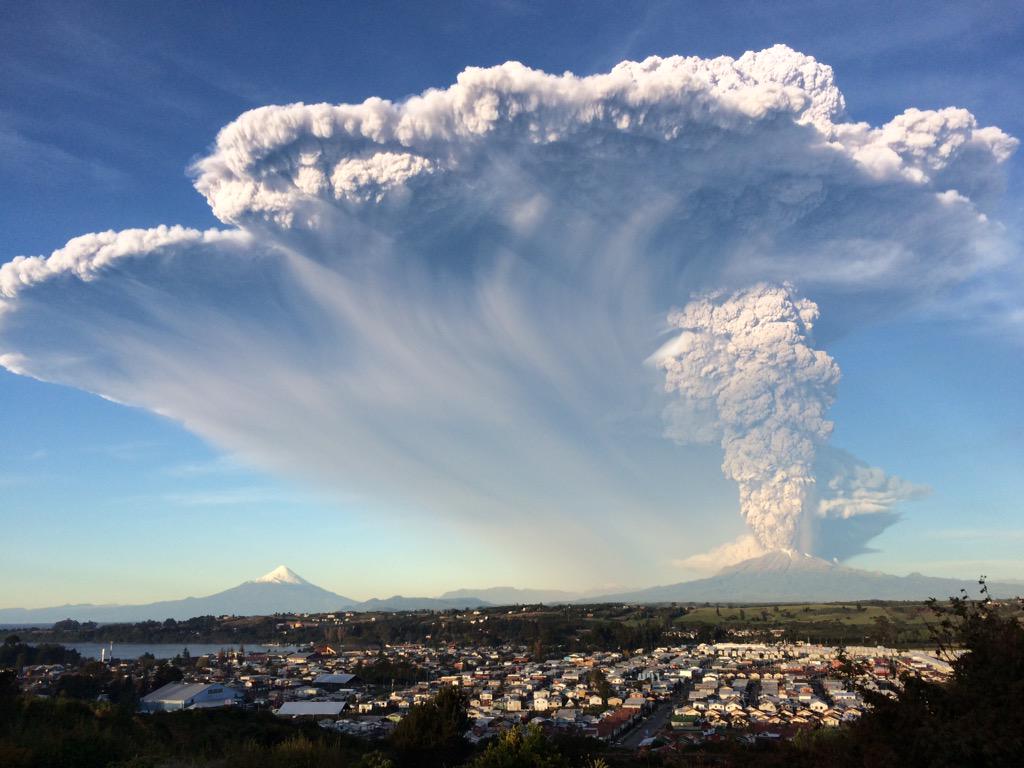Mysterious clouds form 'god-like' figure over volcano
AFP
April 27, 2015, 5:44 am
Ash from Chile's Calbuco volcano has heaped more misery on air passengers across South America, as towns and cities struggled to clean up from last week's two powerful eruptions.
A sleeping giant for more than 50 years, Calbuco sprang to life in spectacular bursts of ash and lava Wednesday and Thursday, forcing 6,500 people living nearby to evacuate and blanketed southern Chile in suffocating volcanic debris.

Ash from Chile's Calbuco volcano has heaped more misery on air passengers across South America, as towns and cities struggled to clean up from last week's two powerful eruptions. Photo: Reuters



Ash from the volcano has wrought havoc with air travel in the Southern Cone region of South America, causing delays and cancellations for several international flights to and from Argentina, Chile and even Uruguay.
Flights were still suspended completely in the Argentinian resort city of Bariloche due to the ash.
A column of ash was still traveling northeastward Sunday, but it was smaller than in previous days.

Smoke and ash rise from the Calbuco volcano, seen from Puerto Varas city, south of Santiago. Photo: Reuters
At the foot of the volcano giant, in the small resort town of Ensenada, its 1,500 inhabitants begin to see the light after its people remained under ashes, thanks to military crews to help in cleaning up the area.
"Now, we just have to think about the future. We hope that in two months, Ensenada will be back to normal. But it will depend on whether the volcano leaves us alone," restaurant worker Pedro Gonzalez told AFP.
Armed forces are guarding the affected area, which includes the cities of Puerto Montt and Puerto Varas, both under maximum red health alert in the Los Lagos region, about 1,300 kilometers (800 miles) south of Santiago.
On Saturday, the government confirmed it would be providing financial aid to rebuild the affected areas, and would seek to evacuate some 4,000 sheep and 350 cattle and small animals trapped in ash-covered Ensenada.
Farmers are also due to receive help to cover the huge losses triggered by the volcanic material, in a region that relies heavily on its agriculture and tourism industries for income.
A state of emergency has been in place since Wednesday and authorities evacuated a 20-kilometer radius around Calbuco.
The volcano is located in Los Lagos, a region popular with tourists for its scenic mountain landscapes dotted with volcanoes and lakes with black-sand beaches.
The national emergency office ONEMI maintained that exclusion zone, which has forced the evacuation of nearly 6,000 people amid fears of another eruption.
- A sea of ashes -
Calbuco, which has already spewed 210 million cubic meters (7,420 cubic feet) of ash, is considered to have the fifth largest volcanic ash emissions on record.
In a report, the Chilean Meteorological Office warned that "a remnant of the ash plume is affecting the Lake Region with an estimated ceiling of 4.5 kilometers."





It forecast that the ash would keep moving northeast in Argentinian territory.
The 2,000-meter volcano last erupted in 1961 and showed light activity in 1972, according to official data. There have been no known fatalities from this week's eruptions.
It is the second volcano to erupt in Chile since March 3, when the Villarrica volcano emitted a brief but fiery burst of ash and lava.
Chile has about 90 active volcanoes.
The long, thin country has been hit by a series of natural disasters in recent months, from flooding in its usually arid north, home to the world's driest desert, to wildfires in its drought-hit southern forests.
